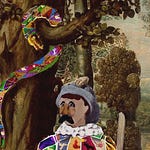XIV. PIERROT VOLEUR
Les rouges rubis souverains, Injectés de meurtre et de gloire, Sommeillent au creux d’une armoire Dans l’horreur des longs souterrains.
Pierrot, avec des malandrins, Veut ravir un jour, après boire, Les rouges rubis souverains Injectés de meurtre et de gloire.
Mais la peur hérisse leurs crins : Parmi le velours et la moire, Comme des yeux dans l’ombre noire, S’enflamment du fond des écrins Les rouges rubis souverains ! XIV. PIERROT, THIEF
The most excellent red rubies, embalmed with murder and glory, sleep in a cabinet’s cavity in the horror of long deep tunnels.
Pierrot, with some highway robbers, decides, after drinking one day, to steal the most excellent red rubies, embalmed with murder and glory.
But fear sets their hair on end: amidst the velour and the mohair, like eyes in the black shadows, there burn at the bottom of jewel-boxes the most excellent red rubies!
NOTES (by line number, starting with the title).
2 souverain : Of the highest quality.
3 injectés : Since its first DAf appearance in 1762, the principle denotation of the verb injecter has been a medical procedure: to use some instrument to inject some fluid into some part of a patient’s body for some medical purpose; the range of possible instruments, liquids, body parts, and medical purposes has slowly expanded since. DAf1835 introduced a secondary denotation, in which the body is a cadaver, the body parts are its blood vessels, the liquid is a dye (or mercury), and the purpose is anatomical rather than medical—either to preserve the body or to guide and facilitate its dissection; in particular, « Cadavre injecté » denoted a body embalmed in precisely that manner. DAf1878 adds (and DAf1935 labels explicitly as figurative) a few idioms: « Face injectée, Face colorée par l’afflux du sang. Yeux injectés de sang, ou simplement, Yeux injectés, Yeux où l’engorgement du sang fait paraître de petites veines rouges », ‘Injected face, Face colored by a rush of blood. Eyes injected with blood, or simply, Injected eyes, Eyes where a surplus of blood causes little red veins to appear’. Apparently Giraud’s rubies, embalmed with murder and glory, burn in the black shadow like specifically bloodshot eyes.
gloire : Perhaps simply ‘glory’; but perhaps (particularly in light of the image in the final three lines) also alluding to the painterly meanings having to do with light (XII.6, XIX.12).
5 souterrain : Tunnel; more specifically, « Lieu voûté, pratiqué sous terre et ordinairement sous le rez-de-chaussée d’un édifice », ‘A vaulted space, dug underground and ordinarily below the street level of a building’.
6 malandrins : Literally, highway robbers; according to Picoche, a 14th century borrowing from Italian malandrino (with the same meaning), composed from Italian malo, ‘bad’, and Middle German landern, ‘to wander about, to be a vagabond’. (See also Flemish lenteren, ‘to walk around idly’, in A. Scheler’s derivations of LANTERNE, p. 300, and LANDORÉ, p. 303, in Dictionnaire d'étymologie française [etc.] (Librarie C. Muquard, Bruxelles, 1888). DAf1878, the first edition to include the word, has an example sentence that incidentally reports a useful fact: « On appelait malandrins, au quatorzième siècle, des bandes de pillards qui infestaient la France », ‘Malandrins was the name for bands of looters that infested France in the 14th century’. It would not surprise me if the malandrins in this rondel were some of Pierrot’s fellow actors.
10 hérisse : All editions of DAf define hérisser more or less as ‘To raise up. Properly said of Animals who raise their hairs or their feathers’. The current edition of DAf gives an etymology: « xiie siècle, hericer. Issu du latin populaire *ericiare, dérivé du latin classique hericius, hérisson », ‘12th century, hericer. From Vulgar Latin *ericiare, derived from Classical Latin hericius, hedgehog’. (Hedgehogs’ spines are not hairs: like claws and feathers, they are made of keratin.)
crins : All editions of DAf define crin more or less as ‘Long coarse hair from the mane or tail of horses and some other animals’; but according to BDLP in Belgian French crin means « Blessure profonde dans la chair (spécialement à la tête) », ‘A deep flesh wound (particularly on the head)’, i.e., a ‘gash’. The anonymous author of Chez les Wallons de Belgique (vol. VIII, 1902, of KR 𝛶PTADIA, an annual collection of mostly obscene folklore) reported that the Walloons of Liège used crin for « fente », ‘crack'. Both ‘gash’ and ‘crack’ are misanthropic dysphemisms, classified as “taboo” by Wentworth and Flexner (Dictionary of American Slang, Crowell, 1960) for ‘vulva’. I think it is extremely likely that Giraud means Pierrot’s (erectile!) « crins » to have sexual overtones.
11 moire : See XII.13.
13 écrins : Plural of écrin, from Latin scrīnium, a circular box of indeterminate size for general storage; adopted into French by the 12th century, with the meaning (since at least the 17th century) of a small box of indeterminate shape for storing jewelry in particular. Semantic drift can be weird and wonderful.









Share this post